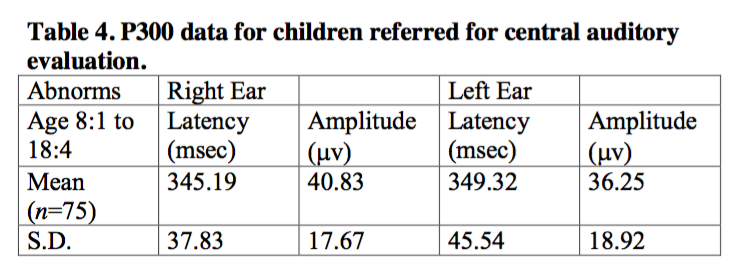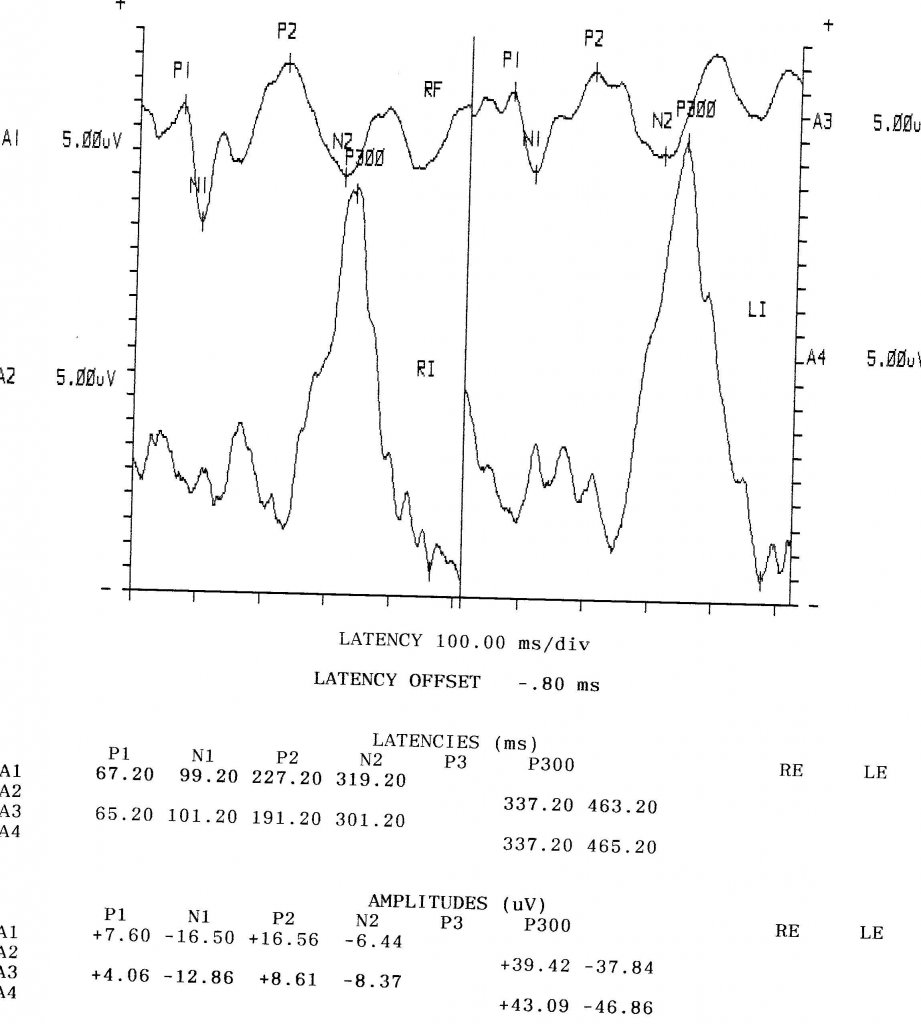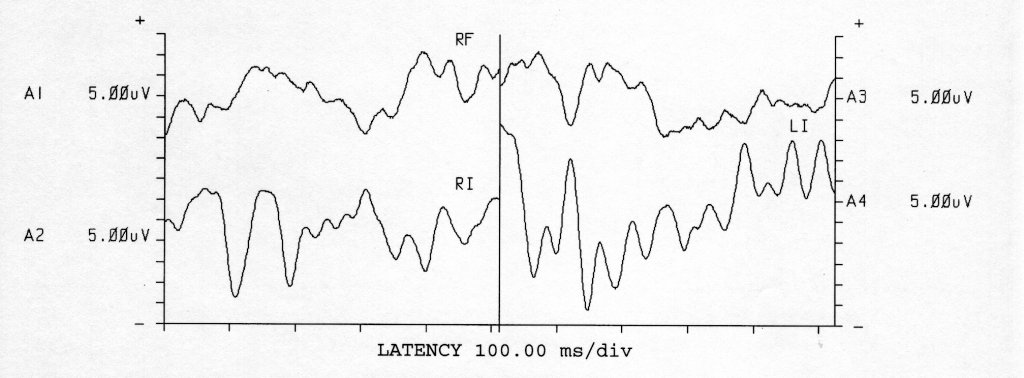NORMAL CENTRAL AUDITORY PROCESSING WITH ABNORMAL P300 RESULTS
The P300 response is produced by a preconscious neurologic cueing device. This device notices differences that are transduced centrally via the sensory systems from the environment. It is a multisensory mechanism that receives input from visual, auditory and somatosensory systems. It is not directly in line (series) with any sensory system, it is monitoring what goes through and responds if something new or different occurs alerting the conscious/cognitive level. There are two devices, one in each hemisphere.
The P300 response is obtained using the “odd-ball” paradigm. Two stimuli (500 Hz tone pip and a 2000 Hz tone pip) are presented at supra-threshold levels such that one is frequent and the other is rare. I use a frequent 500 Hz tone (thump) and a rare 2000 Hz tone (chirp). The rare stimulus is presented 10% of the time using a random number generator so that the timing is not predictable. The patients are instructed to count the chirps silently. Stimuli are presented at one per two seconds and collected across 500 msec per sweep. Averaging is complete when 10 responses to chirps are collected and usually about 90 responses to thumps. The average to the thumps results in a Late response while the average for the chirp results in a late response plus the P300 response. I will usually subtract (arithmetically) the Late response from the Late+P300 response leaving the P300 to be evaluated (Figure 1).

Figure 1. An example of the subtraction technique used to extract the P300 waveform from the response to the rare stimuli. Measurement of amplitude and latency were obtained from the subtracted waveforms (P300).
I have been evaluating the P300 response since the 1980s at the University of Western Ontario. As an audiologist I was interested in the aspect of attention acquisition via subtle auditory cues (i.e. auditory cueing) in children having difficulty in school and its connection with auditory processing difficulties. We produced some adult norms within a habituation study1 using a Nicolet MED 80 averaging computer (Table 1). After seeing a number of patients that had central auditory and P300 deficits we found a found an adult patient with some right hemisphere central auditory indicators with normal right-ear P300 and absent left-ear P300. She was majoring in English and was having particular difficulty proofreading her essays. This patient on psychoeducational testing turned out to have visual scanning and tracking deficits.

Following these observations I started looking into a hemispheric/behaviour correlation. The right-ear P300 response primarily generated in the left-language hemisphere appears to be responsible for auditory cueing as that side is prepared to process information that is time-based (spoken language). The left-ear P300 response primarily generated in the right-non-language hemisphere appears to be responsible for visual cueing. The right-hemisphere is prepared to handle spatial relations and pattern processing more like the way the visual system perceives its surroundings. Therefore, the right-ear P300 response (in 96% of right-handed people and 70% of left-handed people2 will be responsible for auditory cueing, while the left-ear P300 response will be responsible for visual cueing.
A study on six and eight year-olds was done in order to obtain children’s norms3 using a Cadwell Quantum 84 averaging computer. These results agreed well with some earlier studies4,5 that showed a decrease in P300 latency from young child through young adulthood and then increasing latency into later years (Table 2).

A study was done on 110 children from eight to twelve years of age6 using a Cadwell Quantum 84 averaging computer. This study was done in order to determine if there was a relation between abnormal left-ear P300 responses and visual scanning and tracking behaviour that could affect reading. The Monroe-Sherman crossing-out-letters task7 was given and the scores compared to the left-ear P300 waveforms judged normal or abnormal (using amplitude and latency data) for each subject. The results of this analysis are shown in Table 3. These data show a sensitivity of 0.64 and a specificity of 0.83. The chi square calculated equaled 23.937 with a P=1.25×10−6.
Table 3. Percentile scores for the crossing-out-letters task for normal versus abnormal judgment for the left-ear P300.

A subsequent study was done on 75 individuals referred for central auditory evaluation over a three-month period using a Biologic Navigator E averaging computer.8 Twenty subjects were female and 55 were male. Ages ranged from 8 years, one month to 18 years, four months (mean age 11 years, four months). Each child was evaluated for central auditory deficits, electrophysiologic deficits using brainstem, late and P300 responses and given a visual scanning and tracking test.7
In this study, data were collected for the amplitude and latency of the P300 response for each ear and correlated to scanning and tracking percentile scores.
Table 4 shows the latency and amplitude values for the study group (“abnorms”).

In this group the crossing-out-letters task was given and the scores compared to the left-ear P300 waveforms classified as normal or abnormal (using amplitude and latency data) for each subject. The results of this analysis are shown in Table 5. These data show a sensitivity of 0.75 and a specificity of 0.86.

Figure 2 shows an example of a normal set of late and P300 responses collected in the same manner and on the same equipment as the study group. The late response is at the top of the figure and the P300 response is at the bottom. The right-ear responses are to the left and the left-ear responses are to the right.

Figure 2. Normal Late and P300 responses (10 year-old male).
I have seen patients that have P300 deficits without having central auditory deficits. These children were evaluated using a central auditory test battery developed at Colorado State University and normed on adults. This battery consisted of contralateral competing sentences, filtered speech and binaural resynthesis.9 An additional test the words in ipsilateral competition was developed later at the University of Western Ontario.3

13-year-old female:
Contralateral Competing Sentences: RE 100%, LE 100%
Filtered Speech: RE 88%, LE 92%
Words In Ipsilateral Competition: RE 96%, LE 88%
Normal Brainstem and Late responses.

11-year-old male:
Contralateral Competing Sentences: RE 90%, LE 90%
Filtered Speech: RE 88%, LE 92%
Words In Ipsilateral Competition: RE 92%, LE 92%
Binaural Resynthesis: 75%
Normal Brainstem and Late responses. Absent P300 responses bilaterally.
Both individuals had difficulty with auditory and visual cueing. They appear to be unresponsive or in “outer space.” They were often in trouble for not-listening or not-paying attention. They had no problem listening or maintaining attention once their attention was obtained. An absence of the right-ear (left-hemisphere) P300 response results in a “getting attention” problem not an attention maintenance problem. They often do not know that someone is talking to them therefore it appears that they are ignoring or not paying attention. Therefore, it is very important to both cue them, and to indicate the topic, prior to giving instructions or information.
An absence of the left-ear (right hemisphere) P300 response results in difficulty with reading and writing. The problem is not with reading or writing per se but with the mechanics of reading and writing.
With a visual cueing deficit the P300 does not notice a change or difference in the visual environment resulting in inefficient search and finding behaviour. This will result in trouble finding what one is looking for. Reading and writing require visual access to language areas for word recognition and comprehension. If that were all there was to it then reading disorders would all be either language related or be due to a visual-auditory connection deficit. But in order to allow for efficient reading and proofreading the mechanics of reading must be automated at a preconscious level so that the act of knowing each word and the resultant comprehension of written sentences may be accomplished at the conscious level. Speaking and understanding (through hearing) is accomplished at the speed of sound (temporal processing at a number of levels). And the left-temporal cortex does this very well. So we learn speech and language as time-based information.
The visual system organizes and understands spatial relations and pattern processing in space. Most of the patients that I see have auditory and visual cortex that work well. The problem with reading and written material is that we are displaying time-based information in a spatial array. So which way does time go in space? Does it go from left to right as in English, or right to left as in Arabic? Maybe it should go top to bottom as in Chinese. So it is not built in to human brains which way time goes in space, but if the P300 device is working it will in effect “know” which way to go and signal (oops!) if the eye goes the wrong way, goes off the line or misinterprets words. Therefore, the mechanics of reading are on automatic pilot and corrections are made pre-consciously. Confusion of reversible words, small words and words beginning with “th” or “wh” will occur. Similarly in proofreading we scan for errors and if one pops into view the P300 should signal. Without a functioning P300 response these functions are left to the conscious level and therefore very inefficient and interfere with comprehension and enjoyment of reading.
With visual cueing deficits they will also have trouble copying information from the blackboard because of difficulty finding their place. They are likely to make reversals, spelling errors, spacing and other mechanical errors in written work. They are inefficient and make “typos” with a pencil. They also have significant difficulty getting their ideas on paper because it takes so much time, effort and energy for them to avoid making these errors. Therefore, producing written work is a much greater problem than reading.
If the visual cueing P300 response is working then the conscious level is in charge of the ideas and the pre-conscious device is monitoring the mechanics of writing. So we write what we are thinking. Without this device we are thinking about how we are writing and losing track of the idea. Typing (using proper keyboarding) is an excellent alternative to hand writing. Typing takes the monitoring of producing letters, words, spacing, sentences out of the conscious level so that the conscious level is free for the ideas. We do not type at the conscious level, or the cueing level; we type at the cerebellum (where we ride our bike). The mechanics, in effect, are in the machine. Much more efficient.
REFERENCES
- Ivey RG, Brown-Schmidt H. P300 Response: Habituation. J Am Acad Audiol 1993;4:182−88.
- Bryden MP. Handedness and its relation to cerebral function. Laterality: Functional Asymmetry in the Intact Brain. New York: Academic Press; 1982.
- Ivey RG. Words In Ipsilateral Competition (WIIC) version 2. Unpublished normative study; 1987.
- Finley WW, Faux SF, Hutcheson J, Amstutz H. Long-latency event-related potentials in the evaluation of cognitive function in children. Neurology 1985;35:323–27.
- Brown WS, Marsh JT, LaRue, A. Exponential electrophysiological aging: P3 latency. Electroencephalogr Clin Neurophysiol 1983;55:277–85.
- Ivey RG. The P300 response in children. Hear J 1992;45:10:27–32.
- Monroe M and Sherman E. Group Diagnostic Reading Aptitude and Achievement Tests. (Originally published 1939). Recopyright through C.H. Nevins Printing Co., Bradenton, Fl; 1966.
- Ivey RG. Hemispheric differences of the P300 response relating to sensory input. Unpublished manuscript; 2000.
- Ivey RG, Willeford, JA. Three tests of central auditory function. Human Communication Canada 1988;12:35–43.

